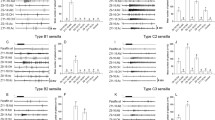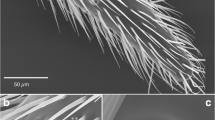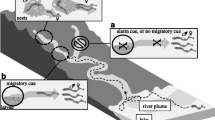Abstract
To identify potential hormonal pheromones of the round goby (Neogobius melanostomus), a species recently introduced to the Great Lakes, we used electro-olfactogram (EOG) recording to examine olfactory responsiveness to more than 100 steroids and prostaglandins. Neogobius detected free and conjugated 18-, 19and 21-carbon steroids, but did not detect prostaglandins. EOG cross-adaptation, used to determine if Neogobius can discriminate the detected compounds at the sensory level, suggested that the detected steroids act on four classes of olfactory receptor mechanisms named (according to the most potent ligand for each): estrone, 17β-estradiol-3β-glucuronide, etiocholanolone, and dehydroepiandrosterone3-sulfate. Although none of the detected steroids induced reproductive behaviors, exposure to steroids from three of the four receptor classes (estrone, 17β-estradiol-3β-glucuronide, or etiocholanolone) increased ventilation rate in males, whereas only etiocholanolone increased ventilation rate in females. Using the ventilation increase as a behavioral bioassay of steroid detection, behavioral cross-adaptation studies in males demonstrated that steroids discriminated at the sensory level are also discriminated behaviorally. These findings suggest the round goby may use steroids as putative pheromones.
Similar content being viewed by others
REFERENCES
Asahina, K., Suzuki, K., Hibiya, T., and Tamaoki, B. 1989. Structure and steroidogenic enzymes of the seminal vesicles of the urohaze-goby (Glossogobius olivaceus). Gen. Comp. Endocrinol. 74:385-391.
Caprio, J., and Byrd, R. P. JR. 1984. Electrophysiological evidence for acidic, basic, and neutral amino acid olfactory receptor sites in catfish. J. Gen. Physiol. 84:403-422.
Cardwell, J. R., Stacey, N. E., Tan, E. S. P., Mcadam, D. S. O., and Lang, S. L. C. 1995. Androgen increases olfactory receptor response to a vertebrate sex pheromone. J. Comp. Physiol. A 176:55-61.
Charlebois, P. M., Marsden, J. E., Goettel, R. G., Wolfe, R. K., Jude, D. J., and Rudnika, S. 1997. The round goby, Neogobius melanostomus (Pallus), a review of European and North American literature. Illinois-Indiana Sea Grant Program and Illinois Natural History Survey. Illinois Natural History Survey Special Publication No. 20.
Colombo, L., Belvedere, P., and Pilati, A. 1977. Biosynthesis of free and conjugated 5b-reduced androgens by the testis of the black goby, Gobius jozo L. Boll. Zool. 44:131-134.
Colombo, L., Marconoto, A., Belvedere, P., and Frisco, C. 1980. Endocrinology of teleost reproduction: A testicular steroid pheromone in the black goby, Gobius jozo L. Boll. Zool. 47:355-364.
Colombo, L., Belvedere, P. C., Marconoto, A., and Bentivegna, F. 1982. Endocrinology of teleost reproduction, pp. 84-94, in C. J. J. Richter and H. J. T. Goos (eds.). Proceedings of the Second International Symposium on the Reproductive Physiology of Fish. Pudoc, The Netherlands.
Cooper, W. E. 1994. Chemical discrimination by tongue-flicking in lizards: A review with hypotheses on its origin and its ecological and phylogenetic relationships. J. Chem. Ecol. 20:439-487.
Crossman, E. J., Holm, E., Cholmondely, R., and Tuininga, K. 1992. First record for Canada of the rudd, Scardinius erythrophthalmus, and notes on the introduced round goby, Neogobius melanostomus. Can. Field Nat. 106:206-209.
Dubs, D. O. L., and Corkum, L. D. 1996. Behavioral interactions between round gobies (Neogobius melanostomus) and mottled sculpins (Cottus bairdi). J. Great Lakes Res. 22:838-844.
Essington, T. E., and Sorensen, P. W. 1996. Overlapping sensitivities of brook trout and brown trout to putative hormonal pheromones. J. Fish Biol. 48:1027-1029.
Friedrich, R. W., and Korsching, S. I. 1998. Chemotopic, combinatorial, and noncombinatorial odorant representations in the olfactory bulb revealed using a voltage-sensitive axon tracer. J. Neurosci. 18:9977-9988.
Irvine, I. A. S., and Sorensen, P. W. 1993. Acute olfactory sensitivity of wild common carp, Cyprinus carpio, to goldfish sex pheromones is influenced by gonadal maturity. Can. J. Zool. 71:2199-2210.
Jude, D. J., Reider, R. H., and Smith, G. R. 1992. Establishment of gobiidae in the Great Lakes Basin. Can. J. Fish. Aquat. Sci. 49:416-421.
Katsel, P. L., Dmitrieva, T. M., Valeyev, R. B., and Kozlov, Y. P. 1992. Sex pheromones of male yellowfin Baikal sculpin (Cottocomephorus grewingki): isolation and chemical studies. J. Chem. Ecol. 18:2003-2010.
Kitamura, S., Ogata, H., and Takashima, F. 1994. Activities of F-type prostaglandins as releaser sex pheromones in cobitide loach, Misgurnus anguillicaudatus. Comp. Biochem. Physiol. A 107:161-169.
Macinnis, A. J., and Corkum, L. D. 2000. Fecundity and reproductive season of the round goby, Neogobius melanostomus, in the upper Detroit River. Trans. Am. Fish. Soc. 129:136-144.
Miller, P. J. 1984. The tokology of Gobiid fishes, pp. 119-153, in G. W. Potts and R. W. Wootton (eds.). Fish Reproduction: Strategies and Tactics. Academic Press, New York.
Moiseyeva, Y. B., and Rudenko, V. I. 1976. The spawning of the round goby, Gobius melanostomus, under aquarium conditions in winter. J. Ichthyol. 8:690-692.
Murphy, C. A. 1998. Olfactory and behavioural responses to putative steroidal pheromones in the round goby, Neogobius melanostomus. MSc thesis, University of Alberta, Edmonton, Alberta.
Murphy, C. A., and Stacey, N. E. 1999. Putative steroidal sex pheromones in the round goby, Neogobius melanostomus: Good correlation between sensory and behavioral discrimination, pp. 599-605, in R. E. Johnston, D. Muller-Schwarze, and P. W. Sorensen (eds.). Advances in Chemical Signals in Vertebrates. Kluwer Academic ?Plenum Publishers, New York.
Murphy, C. A., Maniak, P. J., and Sorensen, P. W. 2000. Functional and biochemical characterization of a novel sex pheromone in the Eurasian ruffe, Gymnocephalus cernuus, p. 211, in Proceedings of the 9th International Zebra Mussel and Aquatic Nuisance Species Conference, Duluth, Minnesota, April 16-30, 1999. The Professional Edge, Pembroke, Ontario, Canada.
Nevitt, G. A. 1991. Do fish sniff ? A new mechanism of olfactory sampling in pleuronectid flounders. J. Exp. Biol. 157:1-18.
Protasov, V. P., Tzvetkov, V. I., and Rashcheperin, V. K. 1965. Acoustical signals in the Azov round goby Neogobius melanostomus (Pallas). Zh. Obshch. Biol. 26:151-159.
Ray, W. J., and Corkum, L. D. 1997. Predation of zebra mussels by round gobies, Neogobius melanostomus. Environ. Biol. Fishes 50:267-273.
Robison, R. R., Fernald, R. D., and Stacey, N. E. 1998. The olfactory system of a cichlid fish responds to steroidal compounds. J. Fish Biol. 53:226-229.
Shepherd, G. M. 1987. A molecular vocabulary for olfaction. Ann. N.Y. Acad. Sci. 510:98-103.
Sorensen, P. W., and Caprio, J. 1998. Chemoreception, pp. 375-405, in D. H. Evans (ed.). The Physiology of Fishes, Second Edition. CRC Press, Boca Raton, Florida.
Sorensen, P. W., and Stacey, N. E. 1999. Evolution and specialization of fish hormonal pheromones, pp. 15-47, in R. E. Johnston, D. Muller-Schwarze, and P. W. Sorensen (eds.). Advances in Chemical Signals in Vertebrates. Kluwer Academic ?Plenum Publishers, New York.
Sorensen, P. W., Scott, A. P., Stacey, N. E., and Bowdin, L. 1995. Sulfated 17a,20b-dihydroxy-4-pregnen-3-one functions as a potent and specific olfactory stimulant with pheromonal actions in the goldfish. Gen. Comp. Endocrinol. 100:128-142.
Stacey, N. E., and Cardwell, J. R. 1995. Hormones as sex pheromones in fish: widespread distribution among freshwater species, pp. 244-248, in F. W. Goetz and P. Thomas (eds.). Proceedings of the Fifth International Symposium on the Reproductive Physiology of Fish. Fish Symposium 95, Austin, Texas.
Stacey, N. E., and Cardwell, J. R. 1997. Hormonally-derived pheromones in fish: new approaches to controlled reproduction, pp. 407-454, in M. Fingerman, R. Nagabhushanam, and M.-F. Thompson (eds.). Recent Advances in Marine Biotechnology, Volume 1. Oxford-IBH, New Delhi.
Stacey, N. E., Zheng, W. B., and Cardwell, J. R. 1994a. Milt production in common carp (Cyprinus carpio): Stimulation by a goldfish steroid pheromone. Aquaculture 127:265-276.
Stacey, N. E., Cardwell, J. R., Liley, N. R., Scott, A. P., and Sorensen, P. W. 1994b. Hormones as sex pheromones in fish, pp. 438-448, in K. G. Davey, R. E. Peter, and S. S. Tobe (eds.). Perspectives in Comparative Endocrinology. National Research Council of Canada, Ottawa.
Sveinsson, T., and Hara, T. J. 1995. Mature males of Arctic char, Salvelinus alpinus, release F type prostaglandins to attract conspecific mature females and stimulate their spawning behavior. Environ. Biol. Fishes 42:253-266.
Tavolga, W. N. 1956. Visual, chemical and sound stimuli as cues in the sex discriminatory behavior of the gobiid fish, Bathygobius soporator. Zoologica 41:49-65.
Valentincic, T., Wegert, S., and Caprio, J. 1994. Learned olfactory discrimination versus innate taste responses to amino acids in the channel catfish (Ictalurus punctatus). Physiol. Behav. 55:865-873.
Van den hurk, R., and Lambert, J. G. D. 1983. Ovarian steroid glucuronides function as sex pheromones for male zebra fish, Brachydanio rerio. Can. J. Zool. 61:2381-2387.
Van den hurk, R., and Resink, J. W. 1992. Male reproductive system as sex pheromone producer in teleost fish. J. Exp. Zool. 261:204-213.
Vermeirssen, E. L. M., and Scott, A. P. 1996. Excretion of free and conjugated steroids in rainbow trout (Oncorhynchus mykiss): Evidence for branchial excretion of the maturation-inducing steroid 17a,20b-dihydroxy-4-pregnen-3-one. Gen. Comp. Endocrinol. 101:180-194.
Waring, C. P., and Moore, A. 1997. Sublethal effects of a carbamate pesticide on pheromonal mediated endocrine function in mature male Atlantic salmon (Salmo salar L.) parr. Fish Physiol. Biochem. 17:203-211.
Wilkinson, L. 1994. Systat 5.05 for Windows. SPSS, Evanson, Illinois.
Zar, J. H. 1984. Biostatistical Analysis, 2nd ed. Prentice Hall, Englewood Cliffs, New Jersey.
Author information
Authors and Affiliations
Rights and permissions
About this article
Cite this article
Murphy, C.A., Stacey, N.E. & Corkum, L.D. Putative Steroidal Pheromones in the Round Goby, Neogobius melanostomus: Olfactory and Behavioral Responses. J Chem Ecol 27, 443–470 (2001). https://doi.org/10.1023/A:1010376503197
Issue Date:
DOI: https://doi.org/10.1023/A:1010376503197




